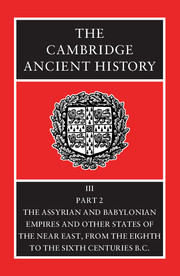Book contents
- Frontmatter
- Contents
- List of maps
- List of text-figures
- Preface
- PART I ASSYRIA AND BABYLONIA
- PART II THE EASTERN MEDITERRANEAN AND THE BLACK SEA
- 29 Israel and Judah from the coming of Assyrian domination until the fall of Samaria, and the struggle for independence in Judah (c. 750–700 B.C.)
- 30 Judah until the fall of Jerusalem (c. 700–586 B.C.)
- 31 The Babylonian Exile and the restoration of the Jews in Palestine (586–c. 500 B.C.)
- 32 Phoenicia and Phoenician colonization
- 33 Scythia and Thrace
- 34 Anatolia
- 34a The native kingdoms of Anatolia
- 34b Anatolian languages
- 35 Egypt: the Twenty-fifth and Twenty-sixth Dynasties
- Chronological Table
- Note on The Calendar
- BIBLIOGRAPHY
- Index
- Map 11: Phoenician and Punic sites in Spain
- Map 13: Scythia
- Map 14: Thrace
- References
34a - The native kingdoms of Anatolia
from 34 - Anatolia
Published online by Cambridge University Press: 28 March 2008
- Frontmatter
- Contents
- List of maps
- List of text-figures
- Preface
- PART I ASSYRIA AND BABYLONIA
- PART II THE EASTERN MEDITERRANEAN AND THE BLACK SEA
- 29 Israel and Judah from the coming of Assyrian domination until the fall of Samaria, and the struggle for independence in Judah (c. 750–700 B.C.)
- 30 Judah until the fall of Jerusalem (c. 700–586 B.C.)
- 31 The Babylonian Exile and the restoration of the Jews in Palestine (586–c. 500 B.C.)
- 32 Phoenicia and Phoenician colonization
- 33 Scythia and Thrace
- 34 Anatolia
- 34a The native kingdoms of Anatolia
- 34b Anatolian languages
- 35 Egypt: the Twenty-fifth and Twenty-sixth Dynasties
- Chronological Table
- Note on The Calendar
- BIBLIOGRAPHY
- Index
- Map 11: Phoenician and Punic sites in Spain
- Map 13: Scythia
- Map 14: Thrace
- References
Summary
Western Anatolia in the pre-Persian era was basically a land of native peoples, survivors from the Bronze Age or acclimatized intruders of the Early Iron Age. Along the west coast, Greek contacts and settlements existed as they did in the Late Bronze Age (CAH III, I, ch. 18a; III.3, ch.39a). The western plateau and the river valleys beyond the estuaries were free of Greek intrusions. We can identify the native peoples and tribes chiefly with the aid of Greek sources and a tenacious nomenclature which in Roman times still aided in establishing provincial entities and boundaries. The peoples emerge classicized as Phrygians, Lydians, Carians, Lycians, also Mysians, Bithynians, Paphlagonians, Pisidians, Isaurians, Lycaonians, to name the most prominent groups. The Pamphylians by their name indicate their Greek and conglomerate origin.
To the east, the neighbours of the West Anatolians were the conquerors and survivors of the Hittite empire and the founders of neo-Hittite kingdoms, their variety reflected in the large number of royal centres. The boundaries of the individual realms are being reconstructed with the aid of Luwian historical inscriptions (CAH III.I, ch. 9). The neo-Hittite kingdoms experienced the advantage and the menace of being neighbours to the north Mesopotamians, who in the past had often forcefully encroached upon Anatolia through economic and military undertakings. In the Iron Age, proximity to Assyria led to vassalage and ultimate annexation. The west of Anatolia was spared this fate, being traditionally outside the Mesopotamian orbit, but this salvation means a loss of information to the historian – the conflicts and subjugation are recorded in Assyrian annals with names, dates, and selective detail about the victims.
- Type
- Chapter
- Information
- The Cambridge Ancient History , pp. 619 - 665Publisher: Cambridge University PressPrint publication year: 1992
References
- 6
- Cited by

